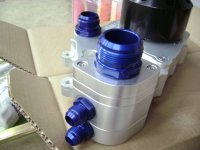From the steering / trans cooler thread:
Tested some Trans / Oil coolers.
To interpret the data look at the Delta# this is how much the fluid cooled in °F per pass.
Notice how the test was done with water and had better performance than the OEM test with oil.
The Deralle has thinner tubes than the MA series. I would use this data when comparing to the thinner water only cores.
Deralle 9000 21 row
Free Shipping - Derale 9000 Series Fin and Plate Transmission Coolers with qualifying orders of $109. Shop Fluid Coolers at Summit Racing.
www.summitracing.com
Thermal Transfer MA4
Data:
78 F Ambient air for all tests
I used tap water for testing not oil
MA4
VA109-ABL321P/N-109A/SH 12V 10" Spal Brushless
4.5 GPM
144 F IN
138 F OUT
Delta 6
Equates to 12,000 BTU/hr with 60° ETD
Manufactures testing shows it should be around 15,000 BTU/hr with 100° ETD with oil
MA has 8.5” x 8” core = 68 square inches
12,000 / 68 = 176 BTU/HR/SQIN factor of cooling
DERALLE 9000 21 Row 13615
VA109-ABL321P/N-109A/SH 12V 10" Spal Brushless
3.65 GPM
141 F IN
131 F OUT
Delta 10
Equates to 15,000 BTU/hr with 63° ETD
Manufactures testing shows it should be around 15,000 BTU/hr with 100° ETD with oil
DERALLE 9000 21 has 11” x 8” core = 88 square inches
15,000 / 88 = 170 BTU/HR/SQIN factor of cooling
The American Cooling Solutions OC-72
Core size 31.8” x 16” x 2.6” is similar construction to the MA series
ACS chart shows 67HP at 100ETD for oil
67 HP = 170,515 BTU/HR
Using MA4 test with water factor 174BTU/HR
31.8” x 16” = 509 SQIN x 174 BTU/HR
88,530 BTU/HR at 60 ETD
147,550 BTU/HR at 100ETD
Using MA232 chart with oil
150,000 BTU/HR at 100ETD
Oil ETD is common around 100° as oil should not get as hot as water.
Water is going to be closer to 135° ETD so an average of 150,000 is going to be around 202,500 BTU/HR or 80HP
I still think the water vs oil is going to have more performance which didn’t show up in the water test in the MA4 but that was at a much smaller scale core.


